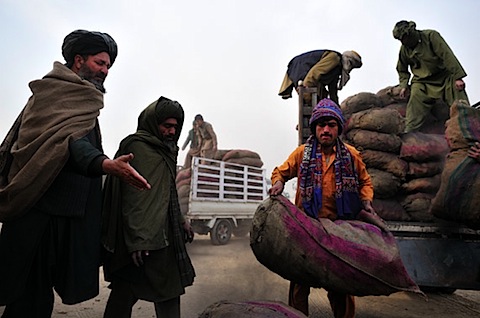
Photo: © Philip Poupin
Thanks to the many kind donations of over a hundred readers of this blog, twitter followers and others, we completed the distribution of materials to those living in two camps in Kabul on January 18th and 20th. By the time we stopped taking donations, we’d raised $9118 from 124 individuals (see at the bottom of the post for a full list).
It’s easiest if I simply give the floor to Orzala, who organised the distribution with help from her brother, Sohrab:
“The story begins with me sitting at the library busy with my studies, while part of me is still thinking about home, people, news and everything else that is happening back at home. Alex sends me a report with some pictures published in a newspaper about the life of internally displaced people coming from southern Afghanistan and living in Kabul …
Staying in the UK for the last 4-5 months, Helmand has become a place I hear the most about, from politicians. I hear most often, success stories and how wonderfully everything works out there. From journalists I hear about war and their pictures of the UK forces in the field, yet the least can be found about the voices of people…. This story struck me in two ways: 1) I found a voice which I could identify with, given my own life experiences as a refugee running away from violence and war, so I couldn’t be passive about them. 2) I thought, I am in danger of being ‘spoiled’, living a comfortable life, warm heated, good shoes, good living conditions and everything I want available for me here, while I just read news about others in challenge and that I have become a typical ‘consumer’ of the news and information.
So I got back to Alex and told him, I am ready to help, if he is to support too, because of all deadlines and too many other priorities on my list. So the idea develops, I start contacting with various friends and organizations dealing with refugees etc. to get a picture about their numbers and also on what organizations are involved for assistance, as usual, the official response is bureaucratic, while a personal response recommends the best option as simply going there and doing it on our own.
I visited Kabul for a short time (even shorter because I was delayed in London for three days on account of the snow!) and most of you will have read my account of a visit to the first camp at Char Rahi Qanbar.
Just a day before leaving Kabul, I learnt that there is another camp, with refugees from (mainly) Helmand and also other southern provinces, around 300 families living in a far more desperate situation, as they get much less attention than the bigger camp in Charai Qanbar. Perhaps so far no report or anything is being published about this other part. I found the situation in some ways harder for them. With conversations I’ve had with around 10-15 men from village, some young, middle aged and some elderly, they all shared their sufferings and why/how they made it to Kabul…
I had to explain who I was and what brought me to see them. I’ve told them about the newspaper and the fact that some of the people who came visited them, read about their situation on the newspapers, decided to provide an urgent assistance, which is only for one time and is meant to at least keep them warm for part of winter if not for whole winter. They were very friendly and said thanks to anyone who is ready to support them in this hard time. One of them told me, we are not used to beg, if people come and help us, we’re grateful, otherwise, we just sit here. Another shared what I exactly also hear in camp one. ‘They are not giving us jobs here [he meant job as in daily labor], they say we look like Taliban’ he smiles. ‘It is not my fault to have the same clothes as the Taliban’!
The wakeel [elder] of the camp provided us with a list, he says there were 250 families before, now another 50 have joined very recently. They are all coming from areas where the military operations are going on. We write up the names of the additional 50 families, the names are given by 5 men who represent the families.
Choosing what to distribute:
The original appeal asked for charcoal, because some of the residents of the first camp mentioned this, and I too was thinking this is the best option working to keep tents warm. However, we faced some challenges: the challenge was the much larger number of refugees in camp one: 870 families in camp one and 300 in camp two. This meant our only charcoal option could not work for mainly financial reasons. We’d have needed at least $2000 to provide them with 50 kgs. On the other hand, we also realised that camp one is already receiving this package of winter assistance from a German NGO which also includes wood as part of that support. Residents and elders of camp two said they had not received this help so far. On the day I visited them, I saw bags of wheat being off-loaded in the camp; we could not 100% verify who brought it (some said it was the Afghan Ministry of refugees, others said it was Aschiana), but I observed they did have wheat for all families.
Taking this situation into account, we decided to provide the families of camp one with 5 kgs of cooking oil, which is one of the top two priorities for food right after wheat, and provide the residents of camp two with 25 kg of charcoal each. The goal for us was to contribute to every family at both camps. The whole decision on what to distribute is result of discussions among the camp residents, men and women whom I visited and spoke with.
Organizing the distribution:
My absence from Kabul made it bit challenging to organize the distribution, but nevertheless, thanks to my brother (the co-founder of Kabul Dreams, Afghanistan’s first indie rock band) who agreed to take the responsibility, it all went smoothly.
Our photographer friend, Philip Poupin, had kindly agreed to be present there as witness and also take photographs of the whole process so that it is documented. Also, Abaceen Nasimi, Alex’s friend, was there to observe the distribution.
Although initially I was thinking to put together a team of volunteers who could help with the distribution (as I had done in previous distributions of this sort), in the process, we found that it would be easier to involve the people themselves. One day before the distribution, Siddique visited both camps, verified the lists for final and identified all representatives for distribution. In camp one they have been pretty well-organized in this way: for the entire camp there were two wakeels. Each wakeel, then, has 10-15 representatives who each represents 5-10 families. The fact that in both camps refugees themselves volunteered to help with distribution confirmed my old message once again: people in difficult situations should not be seen as subjects, or helpless victims; if you give them hope and an opportunity to act, they can be active agents for a better life. This is far too small an example, but it can perhaps lead into a big one, some day!
Similarly, in camp two, people were far more organized than camp one. There were literate men among these refugees who had prepared a much better organized list of all families in the camp. Each 5-10 families (mostly related) were represented by one slightly elderly man. These representatives all gathered and identified how many families they represented. Based on this list the charcoal sacks were distributed among the representatives who would immediately carry them to the tents. If we (I mean myself here) were to organize this distribution, it would take us weeks and we would still miss some families. In a lucky coincidence, some people from the Ministry of Finance had gathered money and bought rice, grains and cooking oil that was being distributed among the families in camp two on the same day after our charcoal distribution was done.
One challenge as it seems was the fact that among distributors no woman was involved, so there may not be pictures of women from the camp. It is simply something we are not supposed to push for, given that most of the refugees are coming from areas where women are still covered and it is a sensitive matter. And women themselves prefer not to be in pictures either.
We would like to thank you all for being so generous in supporting this very important cause. This assistance maybe be too little to be sustainable or help the refugees, but at least a message is conveyed there that not all outsiders agree with the bombings and killings of civilians; not all outsiders are passive readers of the news and looking at their situations and… so, THANK YOU ALL who contributed to this little mission to be a success. We tried our best to make sure that each can of oil and each bag of charcoal entered into each family tent, and that’s best we could do. Our hope is to see them one day back into their fields, orchards and their own little houses.”
And I would like to add my own heartfelt appreciation for all those who donated and helped out in various ways with this appeal. I must admit I was initially skeptical that we would be able to raise the money; I had assumed others were as weary with the progress of the war as I am and that such a small effort, reaching relatively few people, would find little traction. As it turns out, we raised considerably more than our original target and were thus able to contribute in a more extensive way than originally imagined. We all need hope in these difficult times; the generosity of strangers demonstrated here fulfils our need.
[Update/Edit: It occurred to me (and I had some emails) that people might not want their names displayed here, so I took the list of donors down.]
